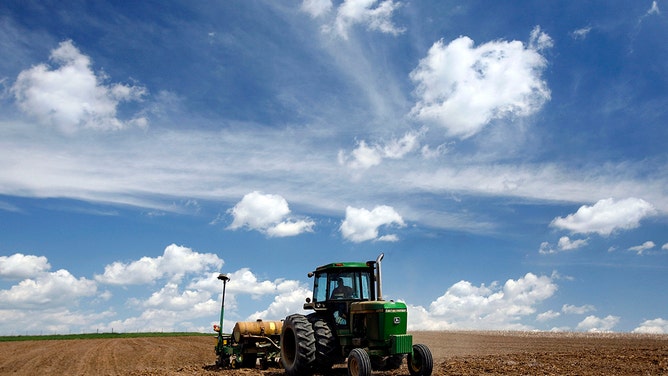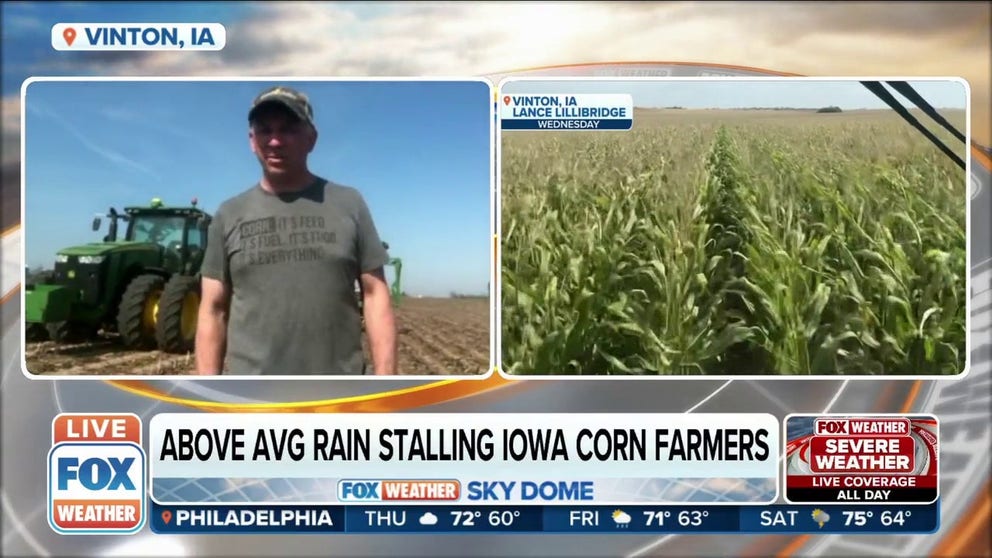'You can take a boat across it': Flooded fields stall Iowa corn farmers in slowest planting season in 9 years
Making sure the right conditions, weather and forecast are ideal. And the 10-day forecast is essential when planting corn.
Above-average rainfall stalling farmers in Iowa from planting corn
Lance Lillibridge, president of the Iowa Corn Growers Association, said the ideal condition for planting corn is dry soil.
VINTON, Iowa – While the West is dealing with a historic drought, farmers in the Midwest struggle with too much rain.
Corn grows best in dry, warm soil. But it’s been a wet, cold spring putting Iowa farmers behind schedule this growing season.
Lance Lillibridge farms in Benton County growing corn, soybeans and alfalfa. He also raises Red Angus cattle and has been farming for over 20 years.
'CORN SWEAT' IN THE MIDWEST CAN CAUSE SOME OF THE MOST OPPRESSIVE HUMIDITY IN THE US
Most years, he starts planting his 2,100 acres of corn around April 20, but it has been delayed this year until May 11.
"Last year at this time we were done. And today, we only have about 100 acres planted. So we’re way behind schedule, and we’ve got some good weather ahead of us here. So hopefully we can get a lot done in a short period of time," said Lillibridge, who also serves as the Iowa Corn Growers Association president.
It’s been the slowest start to the growing season in nine years, according to the U.S. Department of Agriculture’s statistics service.

(FOX Weather)
By May 1, topsoil moisture ranged from 24 to 40% surplus in all Midwestern states except Iowa, Nebraska and South Dakota. On the same date, only 14% of the intended U.S. corn acreage had been planted, according to the USDA.
"There are some fields that are completely flooded. We’ve got some pasture that’s completely underwater – 40 acres underwater. You can take a boat across it," Lillibridge said.
According to the USDA, despite the rain and cold conditions, Iowa farmers made progress in planting corn and soybeans with 2.8 days suitable for fieldwork during the week ending May 1.
Lillibridge’s crop fields are starting to dry out with a few wet spots that will need to be planted around. Still, he thinks he will get it done.
"We’re just going to have to go full steam ahead and keep that moisture over there to the West Coast for right now for next couple of days," he said.
Since the first of the month, 9% of Iowa’s expected corn crop has been planted, 11 days behind last year and nine days behind the five-year average.
‘We only get one chance every year to do this the right way’
Corn farmers want their ground temperatures to be 50 degrees and rising before they plant.
"And we do need moisture in the ground to germinate that that seed. But if you have too much moisture, and it’s too cold, all it will do is rot. And that’s not going to be good for anybody," Lillibridge said.
NEBRASKA FARMERS ON TRACK FOR RECORD-HIGH HARVEST DESPITE WILD WEATHER SWINGS
Making sure the right conditions, weather and forecast are ideal. And the 10-day forecast is essential when planting corn.
"We only get one chance every year to do this the right way. We don’t want to do it twice. We need to make sure that we’re pikcing our time slot to get going and hopefully we’ll get it done here in a short period of time," Lillibridge said.
And if farmers get the corn in the ground too late, that’s a problem. Aside from them being ruined, it also affects the yield.

Iowa farmer Ernie "George" Goebel pulls a corn planter behind his John Deere tractor while planting corn in a field on the farm he was raised on May 9, 2007 near Luxemburg, Iowa.
(Mark Hirsch / Getty Images)
"The later that we plant, the more yield is affected. And a lot of that has to do with the amount of sunshine and heat units that we get," Lillibridge said.
If nice warm weather with plenty of sunshine can exist the rest of the growing season, farmers expect they could still have a bumper crop.
"But if we stay cool and cloudy and not enough heat units, not enough sunshine, then that could really affect our yields," Lillibridge said.
And the delayed start could likely impact food products or prices that rely on corn products.
WEATHER, RUSSIA-UKRAINE CONFLICT LEADING TO SKYROCKETING WHEAT PRICES
"But a lot of our food prices are based on energy and what it takes to ship them and produce them," Lillibridge said.
According to the USDA, there is a 1.3-billion bushel carryout of corn this year.
"There’s plenty of corn out there right at the moment. But that could change in a hurry, especially if we don’t get this crop in a timely manner, and if we don’t get the right kind of weather to grow it," Lillibridge said.
